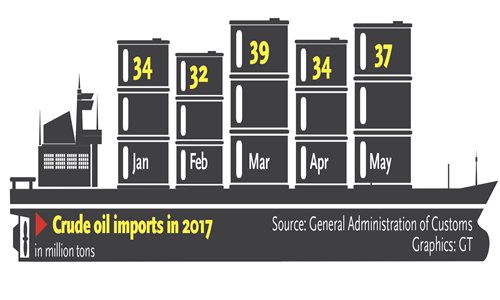(Graphics/GT)
Further growth depends on refined product export policy
China became the world's largest crude oil importer in May, but experts said that imports will only keep growing if government policy allows more exports of refined petroleum products.
Increases in both the volumes and prices of energy, especially for crude oil and natural gas, were behind China's stronger-than-expected import-export data in May, the General Administration of Customs said in a statement Thursday.
From January to May, China imported 176 million tons of crude oil, up 13.1 percent year-on-year. The average price surged 54.6 percent to 2,671 yuan ($393) per ton, customs data showed.
In May, China's oil imports reached 3.72 million tons or 8.76 million barrels per day (bpd), higher than the 8.12 million bpd of US crude imports, financial news portal hexun.com reported on Thursday, citing data from the US Energy Information Administration.
Wu Chenhui, a Beijing-based independent industry analyst, said that the continual rise in crude imports is partly driven by China's own economic needs and by the fact that trade with regions along the Belt and Road (B&R) initiative is in a high-growth period.
"China is weak in crude production and the quality of locally produced crude is relatively low. Added to this, many of the economies in the B&R regions such as the Middle East and Eastern Europe rely on oil exports. These factors together are behind the continual rise in China's oil imports," Wu told the Global Times Thursday.
For instance, at the end of May, the first batch of crude oil from Myanmar reached China via the 1,420-kilometer-long China-Myanmar crude oil pipeline, according to oil major China National Petroleum Corp.
The cross-border pipeline is part of a larger China-Myanmar oil and gas pipeline project.
Along with the rise in import volumes in recent months came fluctuating prices, a trend that has already started in 2016.
Li Li, director of research at Shanghai-based research and consulting firm ICIS China, said that what looks like a surge in oil prices recently is really just a correction from abnormally low prices last year.
However, Li said that whether China can remain the world's largest crude importer will depend on central government's policy concerning refined oil exports.
"The US is becoming a world processing center for crude, and that will drive up US crude imports. In China, though, independent refineries, or so-called teapot refineries, are the main driver for crude imports," Li told the Global Times Thursday.
The Chinese government has allowed 28 independent refinery companies to import crude oil since late 2015 and these plants have import quotas totaling nearly 1.9 million bpd, according to a Reuters report in June. Teapot refineries accounted for 18 percent of China's total oil imports during the first quarter.
With curbs on export quotas and without an apparent rebound in domestic demand, Chinese oil retailers have begun a price war to win customers, Li said.
The country also imported 25.51 million tons of natural gas in the first five months, up 13.2 percent year-on-year, with the price rising 8.3 percent.
Natural gas is still a relatively new energy source for China, and the natural gas market is still growing, so a continued rise in natural gas imports is justified, Li said.
